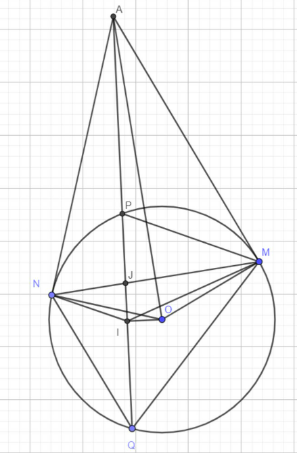Tất cả
Hỏi bài tập Toán Học
Vật Lý
Hóa Học
Tiếng Anh
Ngữ Văn
Hỏi đời sống Tâm lý cảm xúc
Tình cảm
Gia đình bạn bè
Cơ thể & Dậy thì
Giải trí
Mạng xã hội
Định hướng cuộc sống
Hỏi đáp ẩn danh
02/03/2025
Cho đường tròn (O) và điểm A nằm bên ngoài đường tròn. Từ A kẻ các tiếp tuyến ,AM AN với
đường tròn ,O M N là các tiếp điểm). Một đường thẳng đi qua A cắt đường tròn (O) tại hai điểm
,P Q sao cho...
 0
0
-
Câu trả lời phải chính xác, đầy đủ dựa trên kiến thức xác thực:
- ✔ Đối với câu hỏi trắc nghiệm: Đưa đáp án lựa chọn + giải thích lý do chọn đáp án.
- ✔ Đối với câu hỏi tự luận: Đưa lời giải và đáp án cho câu hỏi.
- ✔ Đối với câu hỏi trả lời ngắn: Đưa ra đáp án + giải thích lý do.
- ✔ Chấp nhận sử dụng ảnh do thành viên viết tay, ảnh cần rõ nét, không bị mờ, vỡ ảnh.
- Sử dụng ngôn ngữ rõ ràng, dễ hiểu.
- Tránh đưa ra các ý kiến cá nhân mang tính chất chủ quan.
- Nếu sử dụng thông tin từ nguồn khác, phải trích dẫn nguồn đầy đủ và chính xác.
- Tuyệt đối không được sao chép các thông tin từ các trang khác, từ AI hoặc chatGPT.



02/03/2025
 0
0
02/03/2025

\begin{equation}
\begin{aligned}
&\left.\begin{array}{rl}
\text { Ta có } P I=I Q \\
M a^{-} P, Q \in(0)
\end{array}\right\} \Rightarrow O I \perp P Q\\
&\text { Xét tứ giác AI OM có }
\end{aligned}
\end{equation}
\begin{equation}
\begin{aligned}
& \left.\begin{array}{l}
A \hat{I} O=90^{\circ}(\mathrm{cmt}) \\
A \hat{M} O=g 0^{\circ}(\mathrm{gt})
\end{array}\right\} \Rightarrow \text {tứ giác AIOM nội tiếp } \\
& \Rightarrow A, I, O, M \in\left(O ; \frac{A O}{2}\right) (1)
\end{aligned}
\end{equation}
\begin{equation}
\text { Xet tứ giác ANIO có }
\end{equation}
\begin{equation}
\left.\begin{array}{l}
\hat{ANO}=90^{\circ}(gt) \\
\hat{AIO}= 90^{\circ}(gt)
\end{array}\right\}
\end{equation}
Mà đỉnh N; I kề nhau cùng nhìn cạnh AO 1 góc $90^{\circ}$
$\Rightarrow$ tứ giác ANIO nội tiếp
\begin{equation}
T_{U^{\prime}}(1),(2) \Rightarrow A, N, I, 0, M \text {cùng nằm trên một đường tròn }
\end{equation}
Ta có $A I M=\hat{A O M}\left(=\frac{1}{2} sđ \hat{A M}\right)$
Xét $(O)$ có $A M$, AN là tiếp tuyến $\widehat{A O N}=\widehat{A O M}$
\begin{equation}
\begin{aligned}
& \Rightarrow \hat{A I M}=\hat{A I N} \\
& \Leftrightarrow \hat{JI M}= \hat{JI N}
\end{aligned}
\end{equation}
Ta có $P \hat{Q M}=A \hat{M Q}\left(=\frac{1}{2} s d \hat{P M}\right)$
Xét $\triangle A M P$ và $\triangle A Q M$ có
$\hat{QAM}$ : chung
$\hat{A Q M}=A \hat{M} Q(\mathrm{cmt})$
\begin{equation}
\Rightarrow \frac{A M}{A P}=\frac{A Q}{A M} \Leftrightarrow A M^2=A P \cdot A Q
\end{equation}
\begin{equation}
\begin{aligned}
\operatorname{Ta có} A M N & =N \hat{Q M}\left(=\frac{1}{2} \text { sd } \widehat{N M}\right) \quad(*) \\
A I M & =A O M\left(=\frac{1}{2} sd \hat{A M}\right) \quad(* *)
\end{aligned}
\end{equation}
\begin{equation}
\begin{aligned}
&\text { Xét tứ giác ANOM có }\\
&\left.\begin{array}{l}
\hat{A N O}=90^{\circ}(\mathrm{gt}) \\
\hat{A} \hat{M} O=90^{\circ}(\mathrm{gt})
\end{array}\right\}
\end{aligned}
\end{equation}
\begin{equation}
\begin{aligned}
&\Rightarrow A \hat{N} O+\hat{A M O}=180^{\circ}\\
&\text { MàANO, AMO đối diện }
\end{aligned}
\end{equation}
\begin{equation}
\Rightarrow \text { ANOM nội tiếp }
\end{equation}
$\Rightarrow \widehat{A N M}=\hat{A O M}(* * *)$
ta lại có $A N M=A \hat{M} N(* * * *)$
\begin{equation}
\begin{aligned}
&\text { Xét } \triangle A M J \text { va } \triangle A I M có\\
&\begin{aligned}
& \hat{M A I}: \text { chung } \\
& \hat{A M J}=\hat{A I M}(\text { g.g })
\end{aligned}
\end{aligned}
\end{equation}
\begin{equation}
\begin{aligned}
& \Rightarrow \triangle A MJđồng dạng \triangle A I M(g. g) \\
& \Rightarrow \frac{A M}{A J}=\frac{A I}{A M} \\
& \Leftrightarrow A M^2=A I \cdot A J
\end{aligned}
\end{equation}
\begin{equation}
\Rightarrow A I \cdot A J=A P \cdot A Q
\end{equation}
 0
0
02/03/2025
$\displaystyle \begin{array}{{>{\displaystyle}l}}
P( x) =\left( 3x^{5} -2x^{5}\right) +2x^{4} +\left( -5x^{3} +3x^{3}\right) -x^{2} -2x-2x+1\\
=x^{5} +2x^{4} -2x^{3} -x^{2} -4x+1\\
Q( x) =\left( 3x^{5} -x^{5}\right) -3x^{4} -3x^{3} +3x^{2} -5=2x^{5} -3x^{4} -3x^{3} +3x^{2} -5\\
x^{3} -4x=0\\
\Longrightarrow x( x-2)( x+2) =0\\
\Longrightarrow x=0\ hoặc\ x=\pm 2\\
Vì\ a< 0< b\\
\Longrightarrow a=-2;\ b=2\\
\Longrightarrow P( a) =P( -2) =21;\ Q( b) =Q( 2) =-1
\end{array}$
 0
0
Nếu bạn muốn hỏi bài tập
Các câu hỏi của bạn luôn được giải đáp dưới 10 phút
CÂU HỎI LIÊN QUAN
Top thành viên trả lời







